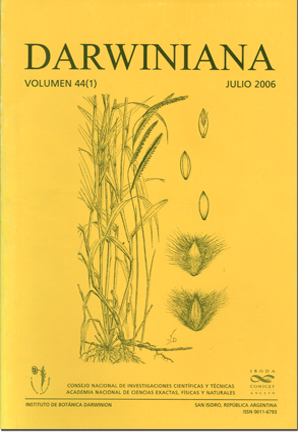Epidermis micromorphology of the lemma in Trisetum and related genera (Poaceae, Pooideae)
DOI:
https://doi.org/10.14522/darwiniana.2014.441.298Keywords:
Trisetum, Pooideae, Poaceae, lemma, micromorphologyAbstract
The micromorphological features of the lemma were investigated in Trisetum and related genera in Pooideae (Poaceae) using scanning electron microscopy to evaluate the circumscription of the genus Trisetum and its systematic relationships. Seventy six species were studied including 32 species of Trisetum and selected species of Amphibromus (1 sp.), Avena (2 spp.), Avenula (6 spp.), Deschampsia (6 spp.), Dielsiochloa (1 sp.), Graphephorum (2 spp.), Gymnachne (1 sp.), Helictotrichon (8 spp.), Koeleria (5 spp.), Leptophyllochloa (1 sp.), Peyritschia (4 spp.), Raimundochloa (1 sp.), Relchela (1 sp.), Rhombolytrum (1 sp.), Rostraria (1 sp.) and Sphenopholis (3 spp.). The results showed that the epidermis of the lemma varies very little within the studied genera, thus it is a good character for the generic circumscription and to study the generic relationships in Pooideae. Trisetum is characterized by rectangular long cells, silica cells usually present, stomata absent, and hooks and prickle hairs present. Differences in the presence of silica cells, prickle hairs and various other epidermal features showed that Peyritschia is distinct from Trisetum. Species of Peyritschia generally lack silica cells, macrohairs and prickle hairs. Silica cells and prickle hairs are usually present in Trisetum and some species have macrohairs covering the lemma. Species examined of Sphenopholis have epidermal cells shorter than species of Trisetum and some species of Sphenopholis have stomata in the apical portion of the lemma. The results suggest that Sphenopholis interrupta (= Trisetum interruptum) should be excluded from Trisetum and classified in the genus Sphenopholis. Deschampsia is very distinct from Trisetum in the epidermal characteristics of the lemma. Studied species of Deschampsia have very long epidermal cells, absence of silica cells, prickle hairs and hooks usually absent, and long cells with straight anticlinal walls. The genera Amphibromus, Avena, Avenula, Helictotrichon, Gymnachne, Rhombolytrum, Dielsiochloa, Leptophyllochloa, and Raimundochloa showed various combinations of micromorphological features supporting their generic distinction among them and from Trisetum. On the other hand, Graphephorum, Rostraria and Koeleria are very similar to Trisetum in the epidermal characters of the lemma.Downloads
Published
31-07-2006
How to Cite
Finot, V. L., Baeza, C. M., & Matthei, O. (2006). Epidermis micromorphology of the lemma in Trisetum and related genera (Poaceae, Pooideae). Darwiniana, Nueva Serie, 44(1), 32–57. https://doi.org/10.14522/darwiniana.2014.441.298
Issue
Section
Structure and Development
License

Starting on 2012, Darwiniana Nueva Serie uses Licencia Creative Commons Atribución-NoComercial 2.5 Argentina .






